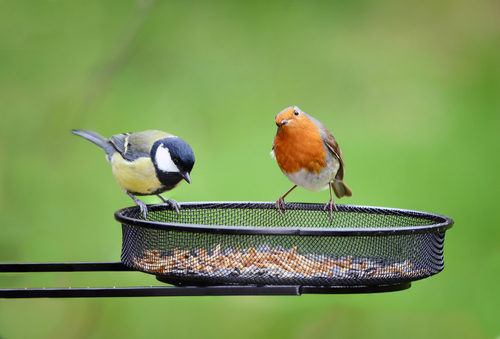Bird Feeding: Choosing the Right Bird Feeder for Your Garden

FAQ about Bird Feeding
Here are answers to some common questions:
What are the best feeders for birds?
Different feeders suit different species best. Tube, platform, and tray feeders work well generally. Specialized options like thistle cakes, mesh pods, and birdbaths are excellent for smaller birds. Suet logs and blocks attract woodpeckers and insectivores. Variety is key to accommodating all visitors.
Where do you place a bird feeder?
Ideally, locate feeders 3-5 meters from dense shrubs, trees, or structures where birds can quickly escape from predators. Partial shade is preferable to full sun. Position feeders at varying heights to include ground feeders up to hanging options 2 meters high. Clean regularly to avoid disease.
What is the quote about feeding birds?
“If you want to attract birds to your garden and give them a healthy, happy home, be sure to include some bird feeders.” – Julie Zickefoose, American author and artist. By offering supplemental food sources and habitat needs, we can meaningfully support local bird populations in our neighborhoods.
What is the simplest bird feeder?
One of the easiest feeders requires no construction, using items likely available – an upside-down pinecone rolled in peanut butter or weighted with seeds. Easy to make, clean, and attract many bird species to dangling cones. String or clips turn any pinecone into an instant backyard bird entertainer.
What birds visit gardens most often?
Common garden birds in Australia include noisy miners, sulfur-crested cockatoos, silvereyes, magpies, willy wagtails, plovers, and butcherbirds. In coastal areas, expect colorful lorikeets and kingfishers. Inland brings crested pigeons and pardalotes. By providing the right foods and habitat features like nest boxes, a wide diversity is possible wherever one lives.
Introduction
As most Aussies know, our native birds are a delight to have visiting your backyard. Whether it’s colorful lorikeets screaming overhead or tiny wrens darting between trees, there’s nothing quite like watching feathered friends up close.
Why Feed Birds?
Before getting into the nitty-gritty of feeders, it’s worth considering why one might want birds flocking to their yard in the first place. Here are just a few of the main benefits:
- Entertainment value – Sitting back with a Stubbie to watch bird antics is a relaxing way to spend an afternoon. Their acrobatic feats and social behaviors never cease to amuse.
- Environmental assistance – By providing food, you aid birds as they go about the important tasks of seed dispersal, pest control, and more. Their contribution to ecosystem health shouldn’t be understated.
- Connection to nature – Having resident birdlife brings you a sense of participation in the natural world right on your doorstep. It’s a small act that can foster greater care for the environment.
- Joy and relief from stress – Studies show watching and listening to birds has positive psychological effects on humans. Their vibrant colors and songs are proven mood boosters.
So, in essence, setting up feeder stations isn’t just a nice thing to do for our feathered friends – it benefits us too. Now let’s explore some specific feeder options!
Bird feeder diy
For those wanting to save a few dollars or get crafty, homemade bird feeders are a great DIY project. Here are some easy designs to construct:
Mason jar feeder – Simply pierce holes in the plastic lid of a jar and thread string or twine through to hang. Fill with seeds.
Gutter bird feeder – Cut short sections from an old rain gutter and secure small perches inside. Mount to fence posts or tree trunks.
Pinecone feeder – Hot glue seeds directly onto pinecones or roll in peanut butter first. Hang upside down from string or trees.
Suet feeder – Melt suet bird cake into an aluminum pie tin or punch holes in the suet itself to harden on a string loop.
All use basic, inexpensive materials lying around the house or hardware stores. With a bit of creativity, you have unique feeders that won’t break the bank. Give them a go!
Bird feeders for small birds
While large parrots and plovers have no trouble accessing traditional tube and platform feeders, smaller birds can get crowded out by their louder cousins. Specialty feeders help attract honeyeaters, wrens, and similar species:
Mesh sack feeders – Filled with seeds and nuts, these hang with an open weave design that little birds can perch inside safely.
Birdbath feeders – Shallow dishes have raised edges for tiny birds to stand in as they eat scattered foods. Double as water sources on hot days.
Thistle feeders – Suet-like cakes peg onto wooden dowels at varying heights. Intricate designs let small birds easily loot the food.
Mesh pod feeders – Hanging orbs have a cage-like exterior and are centrally well-stocked with grains. Ideal for lorikeets and other parrots.
The key is providing abundant food in portions that won’t overwhelm little gizzards. With the right specialized feeders, even some of Australia’s smallest songbirds can join the party.
Bird feeder with stand
To keep feeders off the ground away from unwanted critters like snakes, having them raised on stands is essential. This both protects the food supply and gives you a better bird’s eye view. Here are a couple of stand designs:
Post mount stand – Simply slot cut posts into a base of wooden boards or sturdy plastic that remains stationary no matter the weather. Easy to construct from lightweight materials.
Tub feeder stand – Plastic tubs filled with gravel, sand, or water make low-maintenance stands that won’t blow over in high winds. Bolt or zip-tie feeders directly onto the stable containers.
Elevated platform stand – For multiple feeders, construct a raised wire grid or wooden slat surface elevated a meter off the ground. Provides room for many feeders and allows birds to hop between spots safely.
Regardless of the design, the stand conveniently locates feeders at optimal heights for observation from indoors or patio seating. The key aspects are durability against our crazy climate and adequate protective space underneath.
Hanging bird feeder
For small yards or areas lacking trees, wall-mounted and hanging feeders are great space-saving solutions:
- Swing feeders – Pole feeders with cups that move side to side as birds perch allow ground access protection from all sides.
- Hanging tube feeders – Traditional cylindrical designs use gravity to steadily replenish seeds. Angle outward from mounting points.
- A-frame feeders – Triangular feeders filled with seed cakes stay dry inside during rain. Easy to clean and mount against walls or fences.
- Nectar feeders – Glass or plastic hummingbird feeders hang freely on telescoping poles, extending their reach.
Ensure secure hanging points, hardware rated for outdoor use, and angled projections to prevent feeders from swinging wildly in the wind. Wall space, shade structures, or verandas work well for these handy alternatives.
Bird Feeder DIY: Nectar Bag Feeder
For a fun DIY project utilizing recyclables, try this easy nectar bag feeder:
Materials:
- 1L ziplock bag
- Scissors
- Fishing line or string
- Jar ring from a preserving jar lid
- Sugary water nectar mix (1 part sugar to 4 parts boiled water)
Instructions:
- Cut the bottom off the ziplock bag, leaving about 2cm of uncut plastic along one edge.
- Poke 4 holes evenly spaced along the jar ring using the scissors.
- Thread the fishing line or string through the holes and tie it into a loop to act as a hanger.
- Fill the ziplock bag with about 1/3 of the nectar mix. Clip the bag into the jar ring so it hangs open.
- Hang from tree branches or posts in partial sun. Refill as needed.
Hummingbirds and honeyeaters will love this no sew bird nectar feeder! Enjoy watching them zoom in for top-ups.
